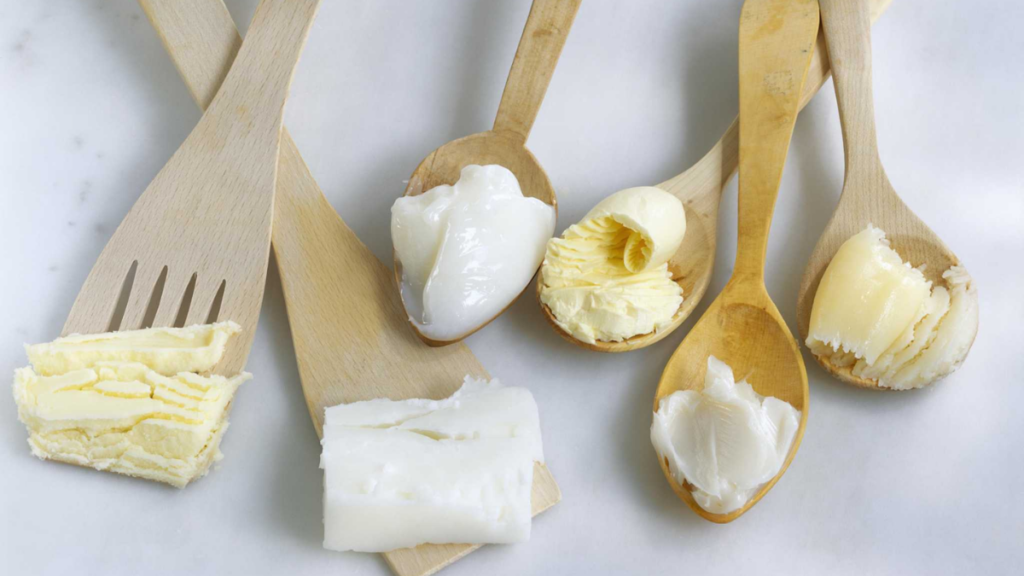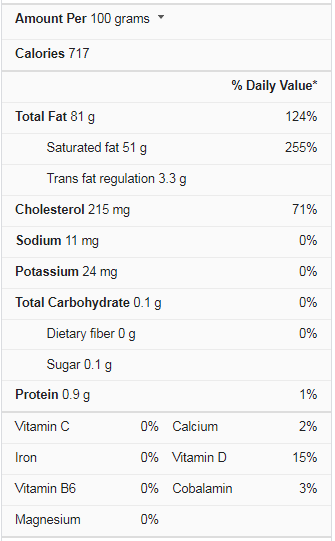Butter takes on a wonderful nutty flavor as the milk solids (proteins and sugars) caramelize as the milk solids (proteins and sugars). Butter complements and enhances the flavors of the food when used as a cooking medium, such as when sautéing vegetables. It also gives sauces a more complex flavor and enhances the flavor and texture of baked goods. Butter can be made in a variety of ways. It’s commonly used by the tablespoon and sliced from a stick of Butter for dips, frying, sautéing, and other uses, and it can be melted for dips, frying, sautéing, and other uses.
Butter has its distinct flavor. Butter is typically soft, creamy, and rich, with just a hint of sweetness, so the term “buttery” is frequently applied to other foods. Many people believe that Butter enhances the flavor of everything. Because it’s used in almost every recipe, you can think of, there’s some truth to that. Butter is used in bread, cookies, cakes, sauces, ice cream, and even beverages, and it’s also delicious in meat, seafood, and vegetable dishes.
Butter Nutrition Facts
What is Butter?
Butter is a fat made by churning the cream of cow’s milk. The top butter producers are India, the European Union, the United States, and New Zealand. Butter is the preferred fat for many cooking applications, including everything from sauce making to baking to simply spreading on bread. Due to its rich, creamy mouthfeel and sublime flavor, no other product can match.
Butter vs. Margarine
Margarine is a popular substitute for Butter, significantly when lowering cholesterol. It’s a refined vegetable oil-based product (often labeled “vegetable oil spread”). Non-hydrogenated margarine contains more monosaturated fats than Butter, with a high saturated fat content. Though there is a noticeable richness in Butter, the taste is similar.
The most crucial factor to consider is how they function when cooking. Butter has a richer flavor and adds to the texture of baked goods due to its fat content. Margarine produces flatter cookies with less flavor and breaks down when fried.
How Many Types of Butter?
Here are the best three types of Butter:
Sweet Cream Butter
Uncultured Butter, also known as unsalted Butter, is made from pasteurized fresh cream. The term “sweet cream butter” was coined to differentiate this type of Butter from the old-fashioned one made with soured cream. The standard Butter in the United States is sweet cream butter, which should be white with a hint of yellow. It has a mild flavor that works well in baking, and it’s also suitable for most cooking tasks.
Salted Butter
It was once a safety concern, and butter was added to slow the spoilage rate before everyone kept their Butter refrigerated. Avoid salted Butter as a general rule to keep the amount of salt in your dishes. Salted Butter should never be used for sauteing because it burns quickly.
Cultured Butter
Made from partially fermented cream, it’s sometimes called “Danish butter” (i.e., partially turned into lactic acid). The cream contains bacteria (because most creams are pasteurized, and therefore all the naturally occurring bacteria are killed). Cultured Butter has a tangier, sharper flavor than sweet cream butter and is widely used in cooking and baking in Europe.
European-Style butter
European-style Butter Has higher fat contents and less moisture than sweet-cream Butter, making it ideal for sauces and pastry making.
Whipped Butter
Nitrogen gas is whipped into whipped Butter, allowing it to stay soft and spreadable even when cold. It is best used as a condiment and should not be used in cooking or baking.
Fermented Butter
Fermented Butter, also known as “preserved butter,” is made from cream that has been aged for weeks or years. These Butter are solid and intense, and they’re usually served as a condiment.
Raw Cream Butter
Raw cream butter is a delicacy rarely found in American grocery stores, and it’s made with fresh, unpasteurized cream from small dairies. It’s an excellent choice for cooking and baking because it tastes more like cream than fat, but it only lasts ten days on the shelf.
Clarified Butter
Clarified Butter, also known as “drawn butter” or “Ghee,” is butter heated to separate the milk solids from the water. It has a high smoking point, making it ideal for sautéing and frying. Make clarified butter at home.
How to Use Butter for Cooking?
Its naturally sweet flavor goes well with a variety of foods. However, it has a low smoke point, and some techniques require an oil that can withstand higher temperatures. But Butter is the best for all other cooking and baking methods.
Pan Frying
Golden brown colors and incredible flavors come from pan-frying minor, thinner cuts of meat or fish in a bit of butter. Melt the butter in a skillet over medium heat. Add the meat or fish once it has melted. Cook while keeping an eye on it and adjusting the heat as needed.
Caramelizing
The natural sugars in chopped or thinly sliced vegetables are brought out by caramelizing them in Butter. Sauté the vegetables in a small amount of butter until they are sweet and beginning to brown, stirring frequently.
Searing
Although Butter isn’t suitable for high-heat searing, there is a way to get the rich flavor without using it. Use a different fat to sear the steak, seafood, or chicken. Add a couple of tablespoons of butter just before it’s done. Baste the meat with Butter using a spoon. It aids browning and adds a new dimension of flavor.
Finishing Sauces
Swirl a tablespoon or two of cold butter into a pan sauce just before serving to add richness and body. Cold Butter is preferable to warm Butter because it reduces the possibility of your sauce separating.
Baking
Butter gives pies, cakes, cookies, muffins, and other baked goods richness, tenderness, and structure. Its effectiveness is determined by its temperature and how it is mixed with other ingredients.
Butter Substitutes
There are numerous butter substitutes available. Depending on the recipe and your personal preferences, you can use either. For frying and sautéing, oils can be substituted for butter, and coconut oil is famous for various products. You can also use margarine or one of the dairy-free butter alternatives.
In baked goods, vegetable shortening is frequently used in place of Butter. However, shortening is 100% fat. If you substitute one for the other, keep in mind that shortening has 20% more fat by weight than Butter, and Butter adds more water to the mix, which could affect the outcome. Baking options include applesauce, avocado, banana, and yogurt.
Should I Cook with Oil or Butter?
Oil and Butter are widely used in kitchens worldwide to create a wide range of delectable dishes. They impart flavor and taste but are not entirely interchangeable. Asian cooking uses a variety of oils ranging from peanut to sesame, whereas Western cooking relies more on Butter and occasionally olive oil. People are becoming increasingly aware of the types of ingredients to use and in what quantities as their awareness of health and nutrition grows. People frequently wonder whether Butter or oil is better. When it comes to sweet and savory dishes, both have different applications.
So, which is the healthier option? Let’s start by defining the distinction between the two. Oil is mainly made up of unsaturated fats like mono- and polyunsaturated fatty acids, whereas butter (commercial butter, not the white Butter we use at home) has a salty flavor and more saturated fats, butterfat, and milk protein, as well as some water.
While Butter contains saturated fats, these fats are heart-healthy, whereas polyunsaturated fats (omega-six fatty acids) in oils are undesirable fats that can cause inflammation and should be avoided. Furthermore, it is common knowledge that Butter is safer for high-heat cooking than olive oil, which is not heated stable and quickly oxidizes at high temperatures. Experts say deep frying with olive oil as a medium should be avoided.
Where to Buy Butter?
Butter can be found in supermarkets, grocery stores, and specialty food stores. Gourmet, specialty, and international Butter can be found at online retailers. Real Butter and higher-quality or organic Butter will cost more than margarine, but it is still relatively inexpensive. Butter is typically sold in 1-pound boxes with four 1/2-cup sticks.
Larger quantities are also available. Spreadable Butter comes in tubs and is made with canola oil to make it easier to spread. Buy unsalted or “sweet” Butter in most cases. The extra salt in salted Butter can throw a recipe off, so adjust accordingly.
Organic Mango Butter
Features:
- Mango Butter, 100% Natural and Pure Mango butter 1 lb Block
- USDA Certified Organic, Free of any Pesticides and other Chemicals.
- Packaged in a Resealable Food Grade Stand-Up Zipper Pouch.
- Unrefined Mango Butter is Loaded with Natural Vitamin A, Vitamin C, and Vitamin E for Maximum Natural Moisturizing.
- We Are The USA Manufacturer And Only Seller of the Mary Tylor Naturals Brand.
Storage
Because Butter hardens when it gets cold, whether or not to refrigerate it arises, softened Butter is, after all, the most common texture for spreading and baking. While it is safe to leave Butter at room temperature for a few days, such perishable items should be refrigerated. For storage outside the refrigerator, an opaque butter dish is ideal. Butter can be frozen in both its original package and a freezer bag, and it should last up to a year in the fridge. Once thawed, use it within a month. If the Butter has an off-flavor or smell or is discolored, it should be thrown out.
Conclusion
Butter is a dairy product that separates fat and buttermilk from whole milk or cream. The fat is compressed and frozen into butter blocks, and it can be eaten straight from the jar or melted for frying or coating. Butter is also used in baking, such as traditional sponge cakes and pastries and sauces.
Salted or unsalted Butter is available. Salt is used for preservation and flavor, but the amount varies depending on the cow’s breed and feed. Because Butter contains approximately 80% fat, many people prefer to use alternatives. Low-fat spreads aren’t usually suitable for baking, so read the label carefully. Some cake recipes use a mild-tasting oil instead of Butter.







